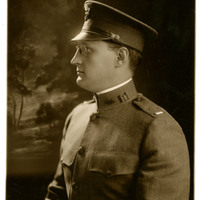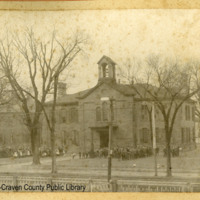Browse Exhibits (2 total)
All Gave Some, Some Gave All - A Veteran's Day Exhibit

In a world often shaped by conflict, countless men and women have made the ultimate sacrifice in service to our nation. Each year on November 11, we pause to honor their courage and dedication, commemorating the end of World War I in 1918, marked by the signing of the Armistice that brought hostilities to a close.
Eastern North Carolina is home to military personnel from every branch of the armed forces, representing communities from across the country. Both Craven County and the city of New Bern have played significant roles in the military history of our nation, bearing witness to pivotal conflicts throughout the 18th and 19th centuries. This exhibit pays tribute to the men and women who have served, and continue to serve, with honor and sacrifice.
We invite you to explore the rich military heritage of Craven County and Eastern North Carolina. From the Tuscarora War of 1711 to the Battle of New Bern in 1862, all the way to World War II, North Carolinians have consistently answered the call to protect and preserve our way of life. Their legacy stands as a testament to the enduring spirit of service that continues to shape our state and nation.
"You must master at the outset a simple but unalterable fact in modern foreign relations between nations. When peace has been broken anywhere, the peace of all countries everywhere is in danger...and that all the United States has to do is to ignore them and go about (our) its own business. Passionately though we may desire detachment, we are forced to realize that every word that comes through the air, every ship that sails the sea, every battle that is fought does affect the American future." - Frankin Delano Roosevelt (1)
1) Franklin D. Roosevelt.Fireside Chat 14: On the European War. September 3, 1939: UVA, Miller Center. https://millercenter.org/the-presidency/presidential-speeches/september-3-1939-fireside-chat-14-european-war#:~:text=Some%20things%20we%20do%20know,wars%20out%20of%20the%20Americas.
Meredith Curtis
The Kellenberger Room
We believe providing access to Eastern North Carolina’s historical record is important for teaching, learning, research, and social change. You may encounter terms or images that are hurtful to you or set off strong emotional responses. We share this message because we care about your experience on the site and want to strike a balance between transparency, access, and inclusivity for our users.
Back To School

Back to school is a busy and exciting time for parents and teachers alike. Students grieve the end of summer, but look forward to a new challenge for the coming school year. When thinking about the excitement, it is often forgotten how going to school looked for our ancestors. Was there a summer reading list? Did students have the same fears and qualities that students have today? This collection gives an insight on how it felt to be a student or a teacher as early as the nineteenth century going into the twentieth century.
The New Bern Academy was the first school in North Carolina to be established in 1766. There are no known records to show any educational establishments before as well as very little account of what New Bern Academy offered in the eighteenth century. By the nineteenth century, the New Bern Academy wasn't the only school running in North Carolina creating a need to expand their faculty and branch out their instruction by December 1823. This put forth the idea of "public education" to become more of a reality. There were no more placement tests or collections of tuition. This idea created an avenue for growth in the number of students, but a decline in the advancement of education. Teachers held the task of transforming teaching to reach a broader dynamic of students of all ages, both boys and girls. (1)
As for an outside point of view apart from New Bern Academy in the nineteenth century, New Bern and the surrounding towns in Craven County began to accelerate and expand their education even further, creating yearly budgets and forming lists of books and documents for the upcoming school year. Within the collection are accounts of expenditures and faculty rules set in place to create a smoother transition into expansion. (3) The economic recession and competition for schooling in the early to mid-nineteenth century and the economic decline after the Civil War show the importance of learning and the pertinence of continuing education throughout every societal change. Even with all of the change, students still showed up to school to learn, even if that meant leaving school early on to work. These photographs and documents are organized and displayed to show their importance not only for today, but for the years before. (2) This collection is "living" proof of the advancement of education in New Bern and Craven County, as well as how students perhaps are the same even during an earlier period.
1) Gadski, Mary Ellen. 1986. The History of the New Bern Academy. New Bern Tryon Palace Commission.
2) Waston, Allan D. 1987. A History of New Bern and Craven County. New Bern Tryon Palace Commission.
3) Lane, John T. and Craven County. Board of Education, “Common Schools in Craven County (1847),” Craven County Digital History, accessed July 24, 2025, https://kellenberger.mycprl.org/digital/items/show/746.